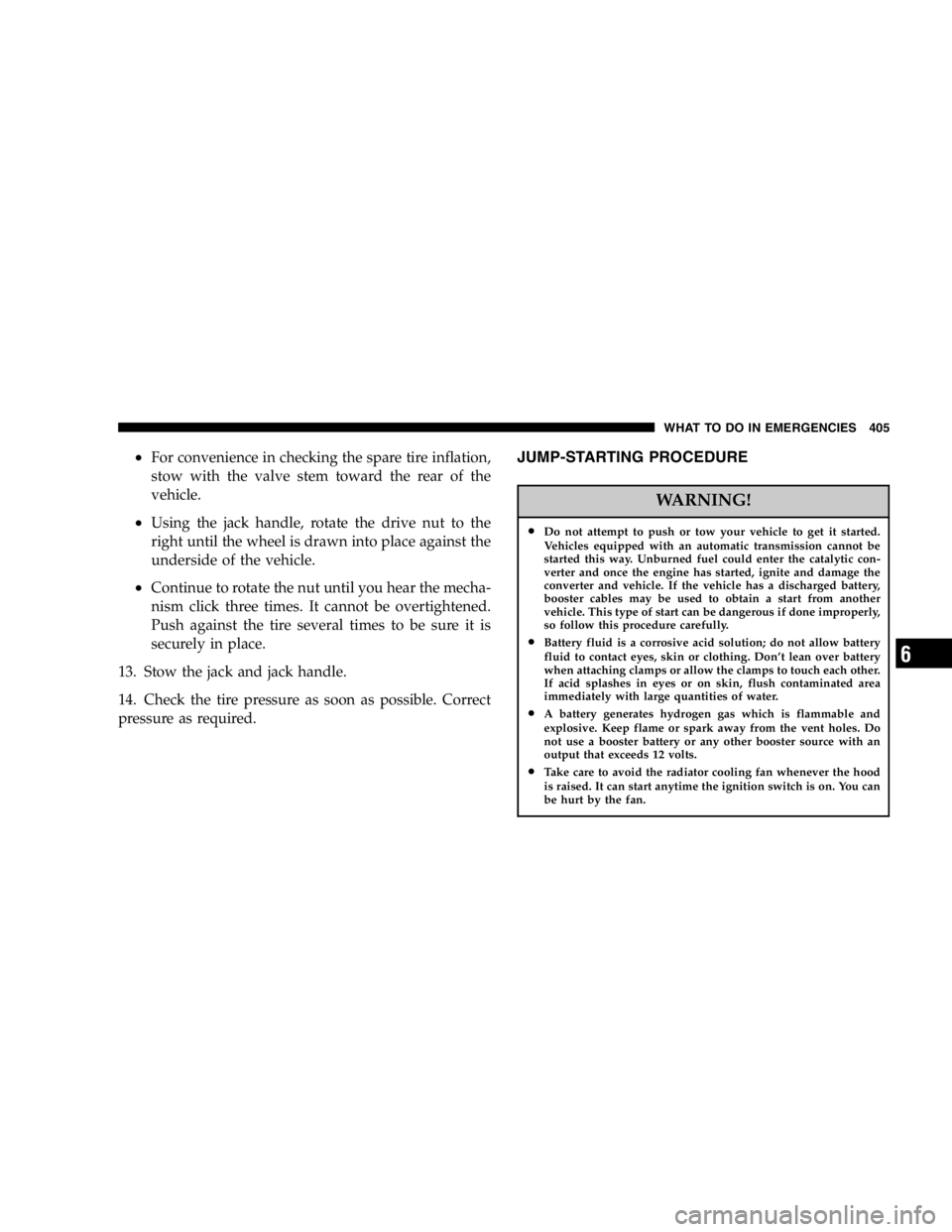Page 405 of 520

• For convenience in checking the spare tire inflation,
stow with the valve stem toward the rear of the
vehicle.
• Using the jack handle, rotate the drive nut to the
right until the wheel is drawn into place against the
underside of the vehicle.
• Continue to rotate the nut until you hear the mecha-
nism click three times. It cannot be overtightened.
Push against the tire several times to be sure it is
securely in place.
13. Stow the jack and jack handle.
14. Check the tire pressure as soon as possible. Correct
pressure as required. JUMP-STARTING PROCEDURE
WARNING!• Do not attempt to push or tow your vehicle to get it started.
Vehicles equipped with an automatic transmission cannot be
started this way. Unburned fuel could enter the catalytic con-
verter and once the engine has started, ignite and damage the
converter and vehicle. If the vehicle has a discharged battery,
booster cables may be used to obtain a start from another
vehicle. This type of start can be dangerous if done improperly,
so follow this procedure carefully.
• Battery fluid is a corrosive acid solution; do not allow battery
fluid to contact eyes, skin or clothing. Don’t lean over battery
when attaching clamps or allow the clamps to touch each other.
If acid splashes in eyes or on skin, flush contaminated area
immediately with large quantities of water.
• A battery generates hydrogen gas which is flammable and
explosive. Keep flame or spark away from the vent holes. Do
not use a booster battery or any other booster source with an
output that exceeds 12 volts.
• Take care to avoid the radiator cooling fan whenever the hood
is raised. It can start anytime the ignition switch is on. You can
be hurt by the fan. WHAT TO DO IN EMERGENCIES 405
6
Page 439 of 520

• Make sure that the radiator and coolant recovery
bottle overflow hoses are not kinked or obstructed.
• Keep the front of the radiator clean. If your vehicle is
equipped with air conditioning, keep the front of the
condenser clean, also.
• Do not change the thermostat for summer or winter
operation. If replacement is ever necessary, install
ONLY the correct type thermostat. Other designs may
result in unsatisfactory coolant performance, poor gas
mileage, and increased emissions.
Hoses And Vacuum/Vapor Harnesses
Inspect surfaces of hoses and nylon tubing for evidence
of heat and mechanical damage. Hard or soft spots,
brittle rubber, cracking, tears, cuts, abrasions, and exces-
sive swelling indicate deterioration of the rubber.
Pay particular attention to those hoses nearest to high
heat sources such as the exhaust manifold. Inspect hose routing to be sure hoses do not come in contact with any
heat source or moving component which may cause heat
damage or mechanical wear.
Insure nylon tubing in these areas has not melted or
collapsed.
Inspect all hose connections such as clamps and cou-
plings to make sure they are secure and no leaks are
present.
Components should be replaced immediately if there is
any evidence of wear or damage that could cause failure.
Brakes
In order to assure brake system performance, all brake
system components should be inspected periodically.
Suggested service intervals can be found in the Mainte-
nance Schedules. MAINTAINING YOUR VEHICLE 439
7
Page 497 of 520

Reset Mode .......................... 317
Selection Of Lubricant ................ 443,463
Shifting ............................. 317
Special Additives ...................... 445
Automatic Transmission ................... 442
Adding Fluid ......................... 444
Fluid and Filter Changes ................. 445
Fluid Change ......................... 445
Fluid Level Check ...................... 444
Fluid Type ........................ 443,463
Ball Joints ............................. 430
Battery ............................... 427
Gas Caution .......................... 427
Jump Starting ......................... 405
Keyless Transmitter Replacement (RKE) ....... 26
Saving Feature (Protection) ............... 153
Bearings .............................. 446
Belts, Drive ............................ 423 Body Mechanism Lubrication ............... 431
B-Pillar Location ........................ 332
Brake Fluid ............................ 463
Brake, Parking .......................... 319
Brake System ........................ 321,439
Anti-Lock (ABS) ....................... 321
Fluid Check .......................... 441
Hoses .............................. 440
Warning Light ........................ 213
Brakes ............................. 321,439
Brake/Transmission Interlock ............... 316
Break-In Recommendations, New Vehicle ........ 88
Bulb Replacement ....................... 456
Bulbs, Light ............................ 455
Calibration, Compass ..................... 169
Capacities, Fluid ........................ 461
Caps, Filler
Fuel ................................ 357 INDEX 497
10